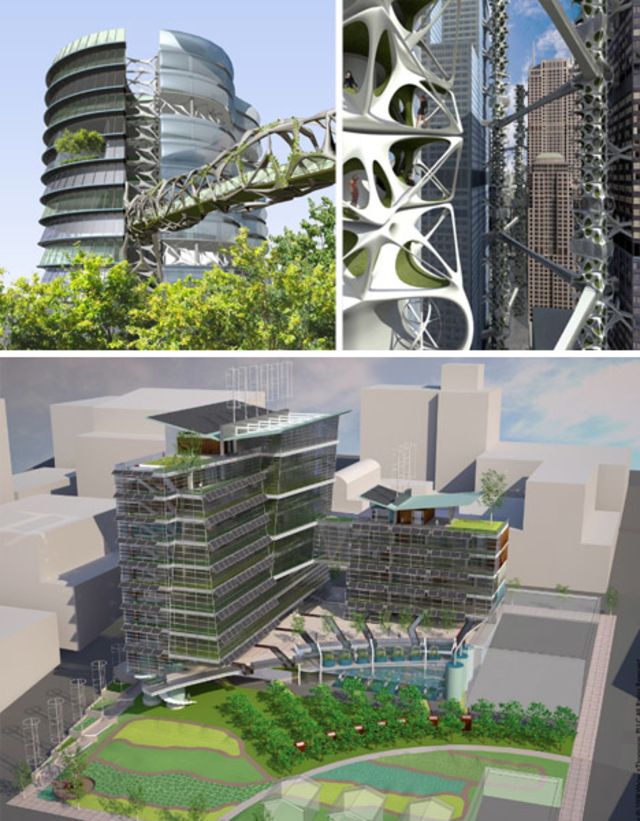
Vertical Farms as Green Building Features
Introduction
Vertical farms have emerged as innovative green building features that address the challenges of sustainable agriculture and urban food production. This article aims to explore the historical background, key concepts, benefits, design features, environmental impact, case studies, current trends, challenges, controversies, future outlook, and significance of vertical farms as green building features.
Historical Background
The concept of vertical farms can be traced back to the early 20th century, but it gained significant attention in recent years due to the increasing need for sustainable food production. Notable milestones in the field include the introduction of hydroponics and aeroponics systems, advancements in renewable energy sources, and architectural integration of vertical farms into buildings.
Key Concepts and Definitions
Vertical farms are indoor farming systems that utilize vertical spaces to grow crops in a controlled environment. They play a crucial role as green building features by promoting sustainable agriculture and reducing the carbon footprint associated with food production. Sustainable agriculture within vertical farming refers to the use of environmentally friendly practices, such as organic fertilizers and pest control methods, to minimize negative impacts on ecosystems.
Main Discussion Points
Point: Benefits of Vertical Farms as Green Building Features
Vertical farms offer numerous benefits as green building features. They enable increased food production in urban areas, reducing the reliance on distant farms and ensuring food security for growing populations. Vertical farms efficiently use resources like water and land, utilizing advanced irrigation systems and maximizing growing spaces. They also contribute to the reduction of transportation and carbon emissions by bringing food production closer to urban centers.
Point: Design and Features of Vertical Farms
Vertical farms are designed to integrate seamlessly into buildings, utilizing available vertical spaces such as walls and rooftops. They employ hydroponics or aeroponics systems, which allow crops to grow without soil, maximizing water efficiency and nutrient absorption. Additionally, vertical farms incorporate renewable energy sources such as solar panels or wind turbines to power their operations sustainably.
Point: Environmental Impact of Vertical Farms
Vertical farms have a positive environmental impact. They reduce the need for pesticides by providing a controlled environment that minimizes pest infestations. Vertical farms also preserve natural habitats and biodiversity by decreasing the conversion of land for traditional agriculture. They contribute to climate change mitigation by reducing carbon emissions associated with long-distance food transportation.
Case Studies or Examples
Real-world examples of successful vertical farms integrated into green buildings include The Plant in Chicago, Green Spirit Farms in Michigan, and Sky Greens in Singapore. These projects have achieved remarkable results in terms of year-round crop production, reduced water consumption, and community engagement. Lessons learned from these projects emphasize the importance of collaboration between architects, engineers, and farmers, as well as the need for continuous research and development.
Current Trends or Developments
The adoption and implementation of vertical farms as green building features are witnessing rapid growth. Recent trends include the use of advanced technologies such as artificial intelligence and robotics to optimize crop growth and harvesting. Innovations in vertical farming systems, such as vertical towers and modular designs, are also gaining popularity.
Challenges or Controversies
Vertical farms face challenges such as high initial costs, making them less accessible to small-scale farmers. Additionally, scalability remains a concern, as large-scale vertical farms require significant investment and operational expertise. Controversies surrounding the environmental impact of vertical farms include debates on energy consumption and the overall carbon footprint associated with their operations.
Future Outlook
The future of vertical farms as green building features appears promising. With advancements in technology, vertical farms have the potential for significant growth and expansion. Emerging technologies like vertical aeroponics and advancements in lighting systems may further optimize crop yields and resource utilization. Vertical farms are poised to play a pivotal role in ensuring sustainable food production and promoting urban resilience.
Conclusion
Vertical farms as green building features offer a sustainable solution to urban food production challenges. Their benefits include increased food production, efficient resource utilization, and reduced carbon emissions. Through architectural integration, hydroponics or aeroponics systems, and renewable energy sources, vertical farms contribute to sustainable agriculture and environmental preservation. Despite challenges and controversies, the future outlook for vertical farms is promising, with potential advancements shaping the future of food production.
References
Despommier, D. (2010). The vertical farm: Feeding the world in the 21st century.
Ng, D. (2017). Vertical urban farming: A viable solution to current food challenges?
Velikov, K. (2018). Vertical farming: Approaches, challenges, and opportunities.
Sanyé-Mengual, E., et al. (2015). Environmental assessment of selected urban agriculture scenarios using substance flow analysis.
Stanghellini, C., et al. (2020). Vertical farming systems: Sustainable innovation for urban agriculture.